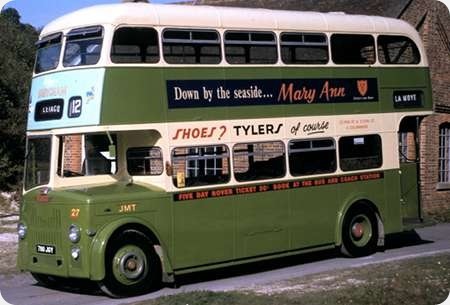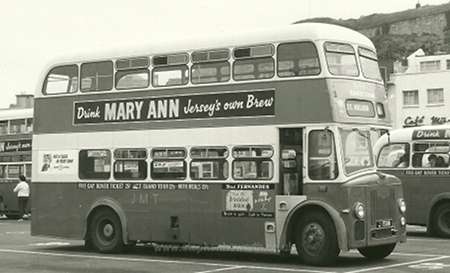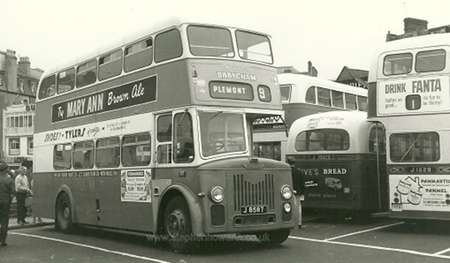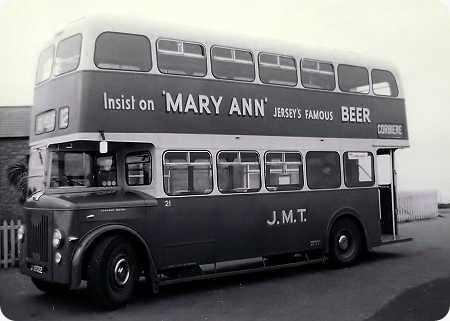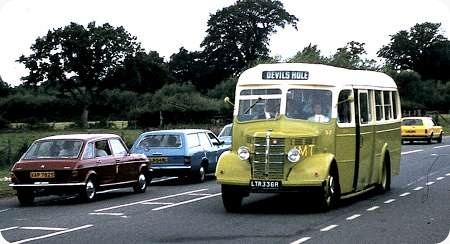
Jersey Motor Transport
1947
Bedford OB
Mulliner B28F
J 6986 was new to Jersey Motor Transport in 1947. She is a Bedford OB with Mulliner B28F bodywork and
fleet number 57. She’s seen passing Beaulieu while taking part in a vintage vehicle run through the New
Forest on 20 August 1978. The registration shown is LTR 336R but she is noted in the PSVC listing for
2012 as being LSU 857.
Photograph and Copy contributed by Pete Davies
05/10/13 - 17:05
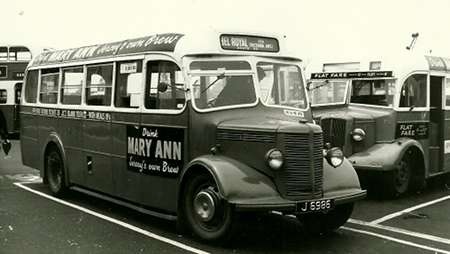
Here is a shot of J 6986 - 57 when in service with JMT it is seen here at the
St Helier - Weighbridge Bus Station.
As with all of JMT vehicles of that era, it has adverts
for ‘Jersey’s own Brew’ Mary Ann. It is waiting to depart on Route 22 to BEL ROYAL via
(Victoria Ave).
A 5 day Rover Ticket was 25/-, JCT (Jersey Coach Tours) All Day Tour 12/3 with
meals 19/6. The window bill is advertising ‘The Sound of Music’, whether this was the film or
a stage production is not known.
No.70 behind is displaying notices for ‘Flat Fare
please pay 6d in the SLOT - Children 4d’.
Stephen Howarth
06/10/13 - 08:08
Thanks for the response, Stephen.
Certainly when I visited the island in
the mid 1970’s, the buses were still advertising that brand. The cars in my posting are waiting to
visit the oversize garage which Lord Montagu has in his garden!
Pete Davies
06/10/13 - 08:08
No. 70 is a 1948 Morris Commercial CVF 13/5 with Wadham FB27F body.
Chris Hebbron
08/10/13 - 07:50
This is a lovely little bus, the Mulliner body makes a change from Duple
bodies on OB chassis. I have always thought it a great shame that so many enthusiasts tended to
ignore Bedfords and Fords. To me they were fascinating vehicles which kept many small independent
stage operators using them on rural stage services.
Don McKeown
08/10/13 - 11:24
I agree with you entirely Don. Not only were the OBs (and even more so their
"War Effort" OWB siblings) fascinating but their performance from a 28hp petrol engine was
unbelievably impressive. They were often in addition subjected to the most abominable overloading
which they handled without a whimper. As far as their aural talents were concerned they were unique
and magnificent - the lusty tuneful roar in the first three gears was classical music to the ears,
followed by calm and quiet in top gear when their gentle rear spring twittering was most enjoyable.
They were also very comfortable indeed, considering that the suspension was completely basic, and
economical to run and simple to maintain - well, we’re talking legends now and legends they were for
me.
Chris Youhill
08/10/13 - 12:53
More than once, Chris, I’ve heard folk, unacquainted with the gearbox
crescendo, associating this with the engine noise and make comments such as, ‘If he keeps
flogging the engine like that, he’ll have the big ends go!’ I agree with the unbustability of the
mechanicals of these little gems so affectionately held in high regard. I sometimes went out of my
way to travel on the Portsmouth Corp’n OWB’s, not so satisfying, because in their latter years they
were on short routes, some only 10-15 mins long! But a kind driver would let me do a return journey
or two if nicely spoken to! Fortunately, no inspector ever came aboard, perhaps because it was an
unrewarding pastime on fringe routes! Route 13, Milton (White House) to Locksway Road was the usual
one, busy solely for the mental hospital it served.
Chris Hebbron
12/10/13 - 08:05
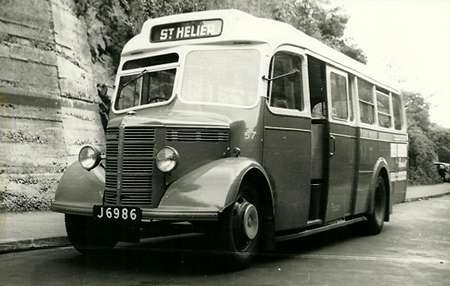
I have found a near side view of J 6986.
Stephen Howarth
24/11/13 - 07:42
The nearside view of J.M.T. Bedford OB with Mulliner bodywork was taken at the
Snow hill bus station in the early 1960’s just after a re-paint loosing its characteristic cream
stripe below the windows which was bordered with a green stripe. originally she had a cream bonnet
top and the cream on the front ran down to the mudguard level.She entered service in June 1947 and
withdrawn in July 1969. Originally used as a coach from new until March 1951 and there after as a
bus.
She ran from 1947 to 1951 in the B.E.A. livery of grey and red before being painted in
the green and cream bus livery. She came from S.C.S ( Safety Coach Service) as a chassis and new in
1946, she was going to be bodied by Jersey Motor Panels for S.C.S but the company was taken over by
the J.M.T in November 1946.
The chassis was sent up to Mulliner for the bodywork to be fitted.
The first vehicle in Jersey to have Mulliner bodywork.
John Luce
10/03/17 - 07:30
My dad used to own what was J 6986 or LTR 336R. He bought her from a man
called Sandy in New Milton Hampshire early 70s. She was in rather a sorry state, as it was being
used as a green house. Dad brought her back to Breamore near Fordingbridge, where he was curator of
the countryside museum there. He completely stripped her down to rolling chassis, repaired and
renewed timber frame where needed. He managed to save the panels and beading on the body, took some
straightening. Gradually she came back to life. He put her back in her Jersey colour green and cream
and named her Maralyn. We used to do Bournemouth to Bath road run with her. Great fun, have to see
if I can find some photos. Dad retired about 1979 and moved down to Tiverton Devon with me. Then in
1981 we all moved to Wellington Somerset needless to say the bus came to. Unfortunately dad had to
sell her, can’t remember where she went, but not long after we heard she was sold on again, I think
she went up to the Kent area,. Dads name was Pat Wale if anyone has the logbook to her. Lost dad
2003, Hope this is of some interest.
Does anyone know where she is now?
Shirley Williams
10/03/17 - 08:40
Thanks for your contribution, Shirley. I lived in Blackfield at the time of my
original posting. I see you mention Tiverton. My wife’s side of the family has a branch there, in
sight of the canal. Small world!
Pete Davies
10/03/17 - 17:31
Hi Peter my family came from Blackfield my aunt still lives there. We used to
live at the Mazery at the top of canal hill Tiverton. We had the bus parked out the back of the
house.
Any relation to Richard Davis from New Milton Hampshire.
Shirley Williams
10/03/17 - 17:35
LSU 857 passed to Dr Mark Sleep t/a Ages Past of Eversley 8/08 and is now part
of his wedding hire fleet. Now painted Green & White there are numerous pics of it on Flickr.
Previous owners in reverse order are:
John Yonge, Kew 4/07
J M Poultney, Minster
11/89
Thorpe, Herne Bay 6/83 (re regd LSU 857 5/88)
Legg, Bishops Lydeard by 11/82
Pat Wale (Countryside Museum) Fordingbridge -/78 (regd LTR 336R)
New to JMT as J 6986
3/47
John Wakefield
11/03/17 - 07:25
No relation at all to the one you mention in New Milton. I have the Welsh
spelling (IES) where he has the English spelling (IS). My grandfather was actually a Welshman!
Pete Davies
11/03/17 - 07:26
Chris Y correctly gives the stated output of the OBs petrol engine as 28 hp,
but this was the RAC rating, an absurdly inaccurate and outdated method of measurement from the
early years of the 20th century that some manufacturers seemed reluctant to ditch. The 3519 cc
engine actually developed 72 bhp, not that far short of the 85 bhp of the Gardner 5LW in many
1940s/1950s double deckers. In the early post war years, a Bedford OB with the Mulliner body could
be bought for £1290, which compared well with the £1415 that was asked for one with a Duple Vista
coach body.
Roger Cox
12/03/17 - 07:42
Despite the obvious price advantage in having the attractive OB Mulliner coach
body, it remained relatively rare, compared with the Duple ones.
Chris Hebbron
12/03/17 - 08:06
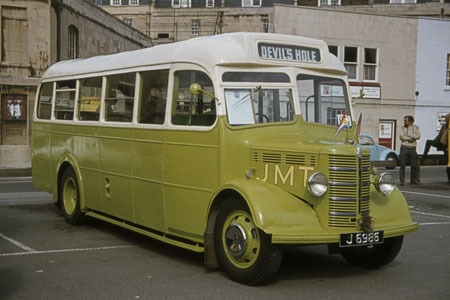
I took this photo of the delightful J 6986 at the end of the Bournemouth to
Bath Rally in about 1977.
John Stringer
12/03/17 - 17:35
Thanks to all its lovely to know the old girls still going strong dad would be
very proud. I see in the photo she still has her lucky heather in the grill mum put that there when
we took her across the New Forest. Now I will have to find those photos won’t I.
Shirley Williams
13/03/17 - 16:29
Roger, the RAC formula was used to determine vehicle tax until 1947. https://en.wikipedia.org/wiki/Tax_horsepower
Stephen Allcroft
14/03/17 - 06:48
Stephen, I confess to being astonished that the RAC engine formula was still
being used for vehicle taxation purposes as late as 1947. I suppose in the early years of the 20th
century using the cylinder bore measurement was a roughly consistent method of assessing horsepower
when long stroke engines were the norm, but the RAC formula very soon became hopelessly inaccurate
as engine design was refined. Its retention until 1947 in official taxation circles seems barely
credible. It just goes to show how remote from reality are our politicians cocooned in their Neo
Gothic ivory tower at Westminster.
Roger Cox
15/03/17 - 07:04
DVLA still get engine capacity wrong. They often get Cubic Centimetres mixed
up with Cubic Inches which of course engines of most buses & commercials are quoted in. So we get
330cc in the case of a 330 cubic inch Bedford engine.
John Wakefield
29/03/21 - 07:03
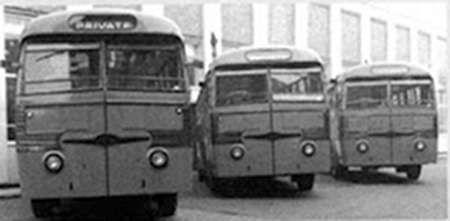
During my research on Daimler Freelines I was pointed to this page in regard
to Mulliner bodies. No less than 22 Gardner-engined Freelines with Mulliner B56D bodies were
supplied to JN Zarpas, in Lagos, Nigeria in 1957/8.
I have only recently found a low-res scan
of 3 of them, which I will try to attach.
Would I be correct in thinking that these bodies
would have been built on the Daimler chassis in Birmingham and exported as complete vehicles, or
would the bodies have been supplied CKD like the Saro bodies for New Zealand?
Jim Neale
